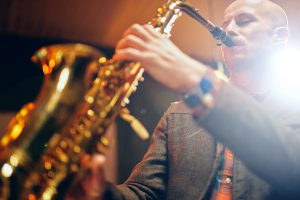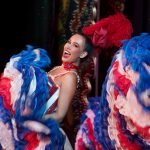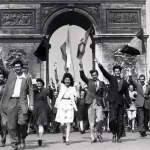The sounds rolling from Montmartre to saint Germain
Birds flying high, You know how I feel, Sun in the sky, You know how I feel
Breeze driftin’ on by, You know how I feel
It’s a new dawn, It’s a new day
It’s a new life
For me
And I’m feeling good…
When one thinks of Jazz and Paris, one must know that this duo involves a major event that
changed the world and its functioning: WW1, the first chemical warfare. Millions of civilians died, an event that was to take the Western World out of the “Victorian Times” and into Modernism. As a consequence of this War, France began playing its role in the distribution and internationalisation of Jazz music. In 1917, the French army hired the 369th regiment of Harlem, barely trained, this regiment were first and foremost a marching band.
Crossing the Atlantic & finding an audience in the horrors of the warfare
In December 1917 the 369th Harlem regiment sets foot on French soil, they find their first audience amidst the horrors of war-torn Brest. After waving to greet the amassed crowds on the approaching pier they began playing a jazzy interpretation of the French National Anthem. Those were the very first notes of Jazz to grace this country, which began the everlasting love affair between France and Jazz music.
After a thorough service training by the French forces, the Harlem Regiment were assigned into
the French army. Their sole mission; to give the boot to the Germans. During their crossing through France, Belgium and the Netherlands, they fought like the land and advancing freedom was theirs and their rigour soon gave them the nickname The Harlem Hellfighters. Along with their fighting force, they were bringing joy to allies that were mentally and physically tired of the war by playing this new musical genre.

The Harlem Hellfighters were the first soldiers to reach the river Rhine, the successful crossing was a major operation in the last leg to encircle and attack the German resistance on the other side. Historical Fun Fact: The Hellfighters threw grenades like nobody else, thanks to their beloved American Sport, Baseball !!!! Consequently the regiment received the French Cross of War like true war heroes. However their recognition was very short-lived as once back in the US, they instantly became second class citizens again – rendering them all back to square one. “It is estimated that the Harlem Hellfighters regimental band travelled over 2,000 miles in France, performing for foreign dignitaries and military commanders, wounded soldiers in hospitals, troops on recreational leave, French citizens, and American Army Headquarters in Paris.” – Cited from the Great War Poetry blog ‘Behind Their Lines’.
Pigalle, the Red Light District where Harlem Renaissance built itself a second home
There were some WWI veterans who held onto that taste of recognition, who were eager to leave their homeland and its segregation behind. Other Americans began to hear stories, and artists, writers, big shots alike wanted to escape not just prohibition but also wanted to take advantage of the great exchange rate U.S. Dollar vs the French Franc. Among the crowds we find Hemingway, Fitzgerald, Guggenheim, Rubenstein, Miller and Pound. Times of social exchange began. It was all about Flapper Girls, Champagne (and cocaine). Paris was a party where Americans from different social classes, cultures and colors were rubbing shoulders – unthinkable in America at this point. Much of this mingling took place in the many cafés that became magnificent playgrounds for creative and intellectual exchanges that opened the doors to a new intellectual development.

Whilst the Jazz Kings were playing for Mistinguette and Maurice Chevalier, Josephine Baker arrived in Paris in 1925 and became an overnight sensation with “La Revue Nègre”. Soon she had her own shows and became her own brand to be Photographed by Man Ray and painted by Fugita. She opened her own Cabaret- Restaurant in Pigalle, bang in the heart of the vibrant Red-Light District, a stones throw from the
Moulin Rouge. Walk down the street a little and you would be in front of “Le Grand Duc” a jazz club managed by Eugene Bullard where Langston Hughes invented Jazz Poetry whilst working as a busboy.
Nearby, Hemingway would get drunk at Chez Bricktop, a whiskey den. Ada Bricktop was Baker’s protégé and part time lover. With Josephine’s help, she managed to open her bar where Django Reinhardt and Grapelli would rehearse whilst Cole Porter and Scott Fitzgerald would fight over her. Around the corner was “Chez Florence”, a name inspired by Florence Emery Jones who performed with her pianist husband Palmer Jones, entertaining Chaplin, Hemingway, F. Scott Fitzgerald, Picasso, Gertrude Stein, Fatty Arbuckle, the Prince of Wales, Peggy Guggenheim…
Prevailing through vinyl
From the early 1930’s, two gents, Hugues Panassie and Charles Delaunay largely contributed to the propagation of Jazz. The first, was the origin of ‘Hot Club de France’, an association that gathered jazz enthusiasts. The second headed the first magazines devoted to Jazz; ‘La Revue du Jazz’ and ‘Hot Jazz’ he also started the record label ‘Swing’ in 1935. Their headquarters on the rue Chaptal in the 9th arrondissement was of course in ear shot of all the best jazz venues. These publications and associations finally gave visibility to the musicians, promoting their work with serious physical content and merchandising.

The expatriate Jazzmen and entertainers that hadn’t left France in 1929, left right before 1939 to escape the socio-political unrest and to defy the outlawing of Surrealism and Cubism along with the ‘degenerate music’ as defined by the Nazi regime. Yet, the vinyls, magazines and the vibrations stuck around. And, so did Miss Baker, who was to play a key role in the French resistance against the Germans.
Occupation during WWII displaced Paris’ jazz scene venues from the hills of Montmartre down
toward the Latin Quarter. Jazz had to be buried and went underground, literally, into the medieval cellars of the historical neighborhood. With their one-meter-thick walls, these locations were perfectly soundproof, thus ace for planning the resistance too. Jazz pioneers coined these new ‘underground venues’ and gave birth to a counterculture known as ‘The Zazous’. They named them selves after Cab Calloway’s track “Zaz Zuh Zaz” which he played at the Salle Pleyel in 1934.
In 1950, Paris Jazz Festival took place at the Salle Pleyel headlining Louis Armstrong, Stéphane Grappelli, Art Tatum, Django Reinhardt and more. Jazz had become a fabulous form of escapism and rebellion of WWII. The Zazous were too young in the 1920’s to have seen the first wave of great musicians play live, but they had the pre-war records and magazines to cling on to. The forbidden is always more attractive. The most illustrious Jazz club in Saint Germain was the Tabou Club run by the surrealist Boris Vian, King of Zazous and resistant, his club officially opened in 1947.

It was during this time that a new cohort of French youngsters learned to play Jazz by listening to
records, forming a new generation ready for freedom. They idolised Sydney Bechet, Louis Armstrong, Duke Ellington, and others. So much so, that when these names came back to Europe in 1948 they were welcomed by masses of fans and journalists. The super stars had returned to the promised land of swag, bringing on the second wave of the Jazz tsunami. Bebop, Bud Powell, Thelonious Monk, Chet Baker and of course the almighty Milles Davies, who’s music was used in many French classics of the film movement ‘La Nouvelle Vague’. France post WWII was very different from the 1920’s, the country was still suffering from its occupied state. But when you listen to the music it created, you can sense the quiet flow of the river Seine going through your veins and spreading its love.
For more (hi)story of Paris during the roaring twenties and the occupation (and after) join our
tours !
If you want to book a tour with My Private Paris: click here!
Article written by Christina







